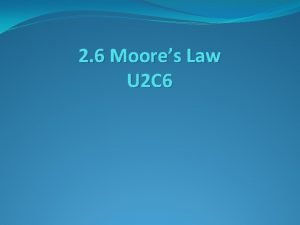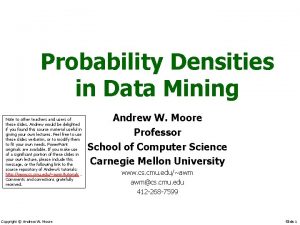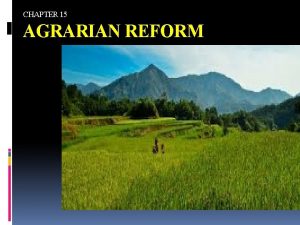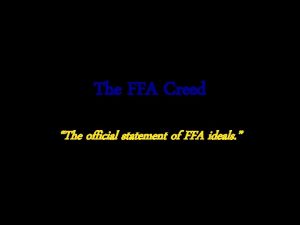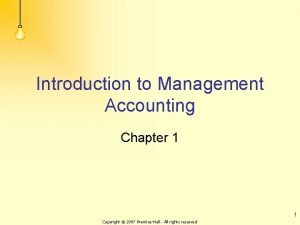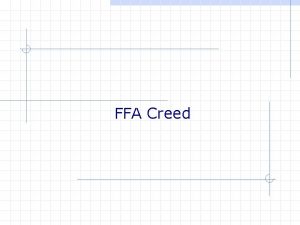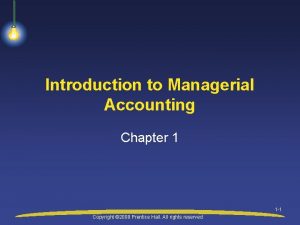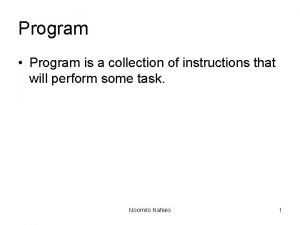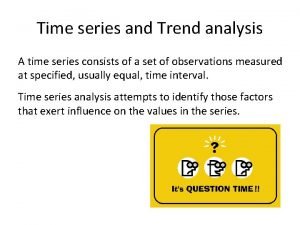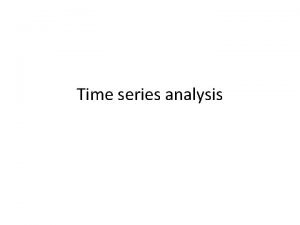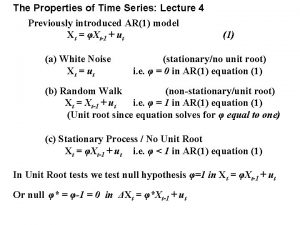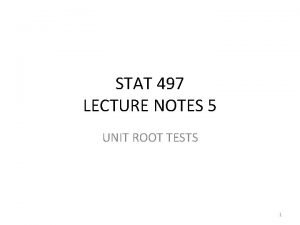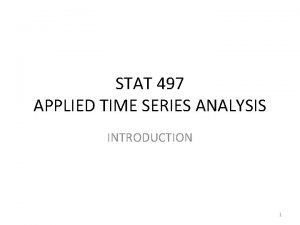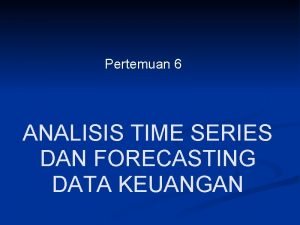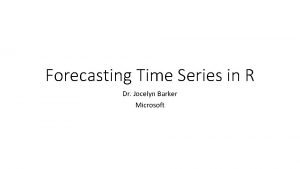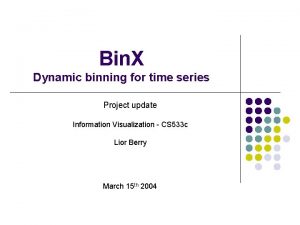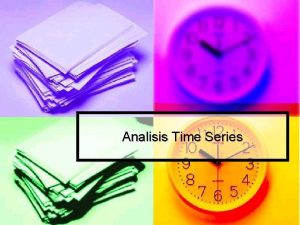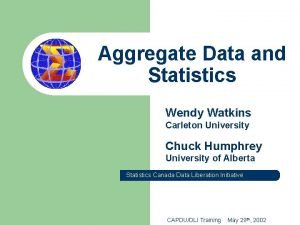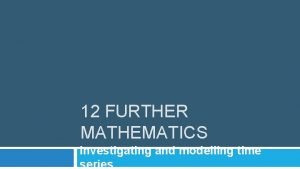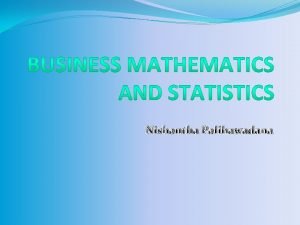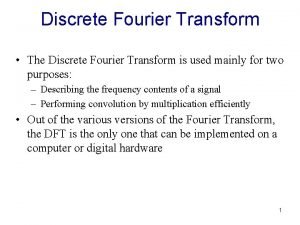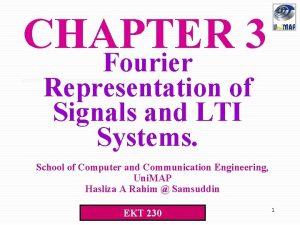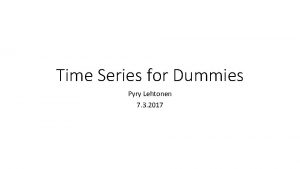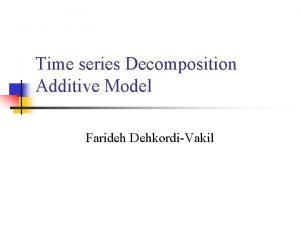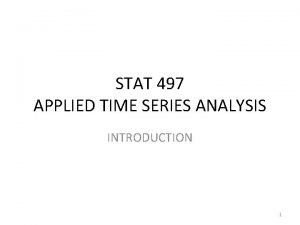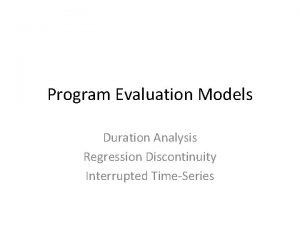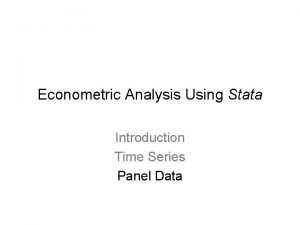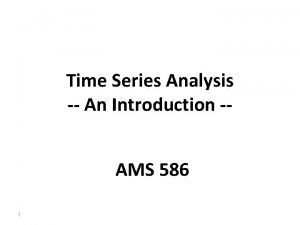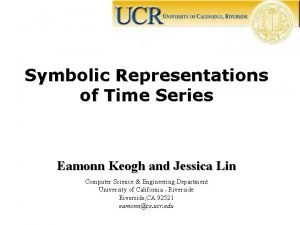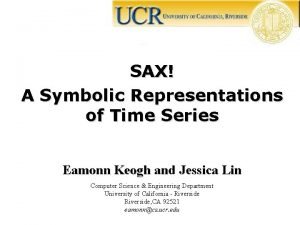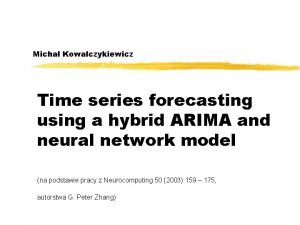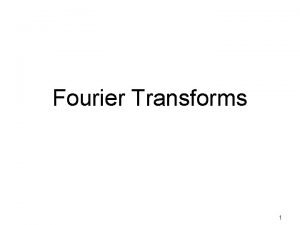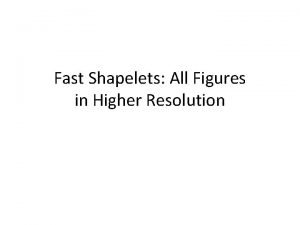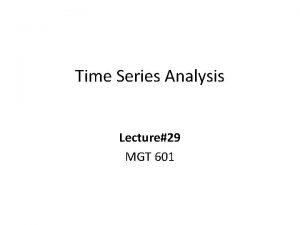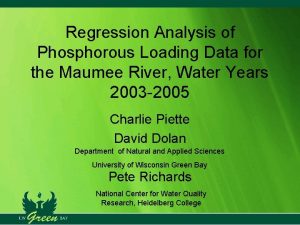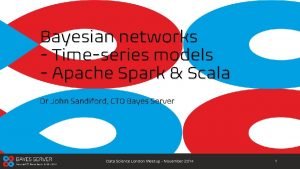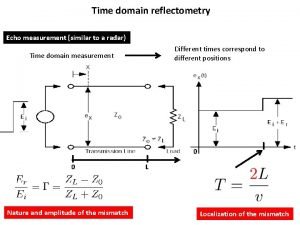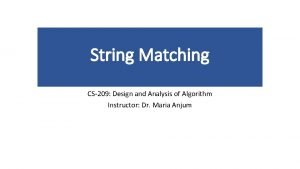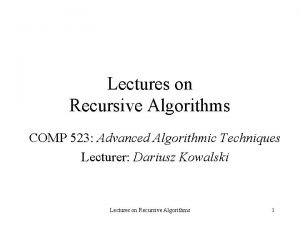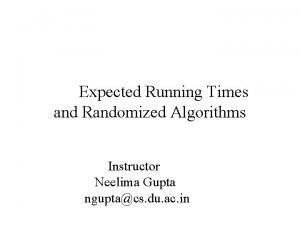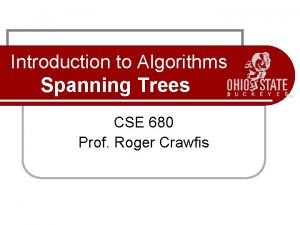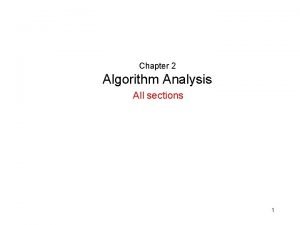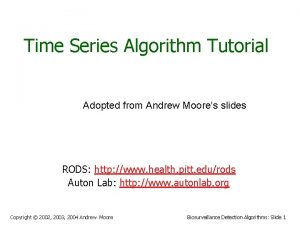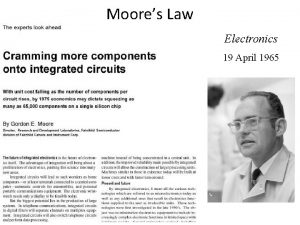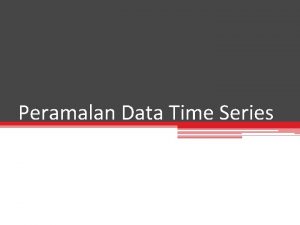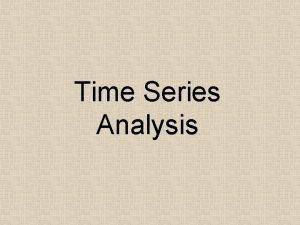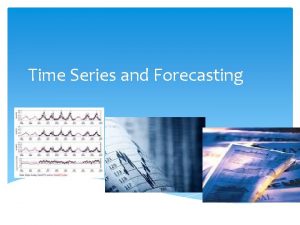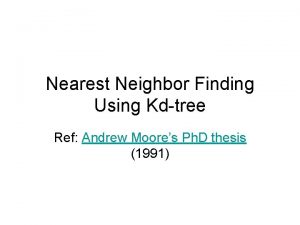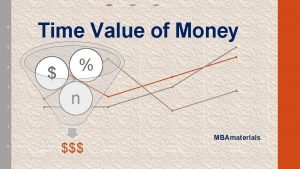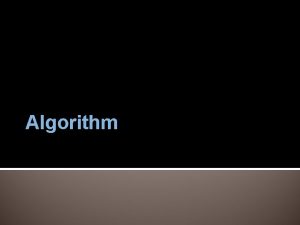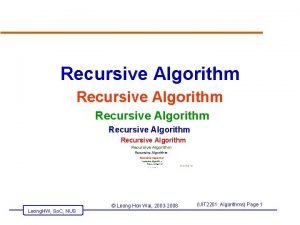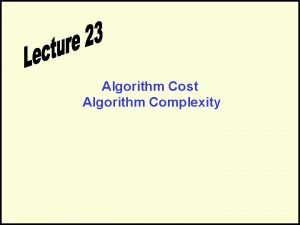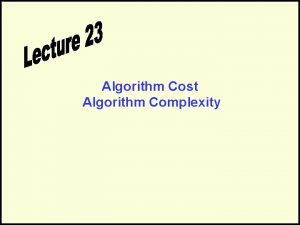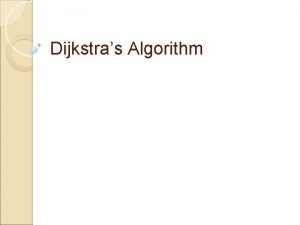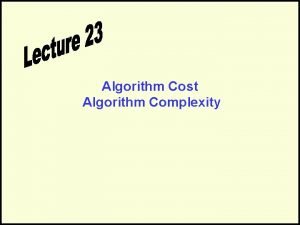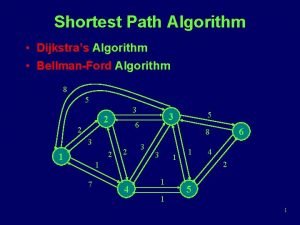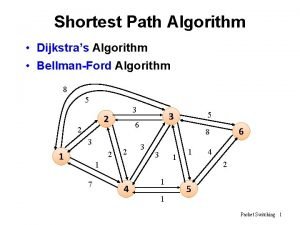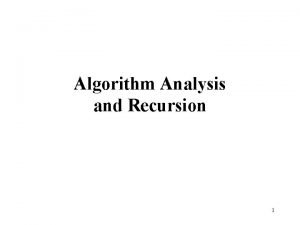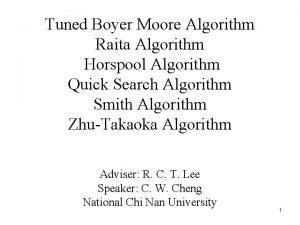Time Series Algorithm Tutorial Adopted from Andrew Moores














































![Day-of-week effects Fit a day-of-week component E[Signal] = a + deltaday E. G: deltamon= Day-of-week effects Fit a day-of-week component E[Signal] = a + deltaday E. G: deltamon=](https://slidetodoc.com/presentation_image_h/1d75b03c0d855e94a9fa765fb25dc471/image-47.jpg)































- Slides: 78

Time Series Algorithm Tutorial Adopted from Andrew Moore’s slides RODS: http: //www. health. pitt. edu/rods Auton Lab: http: //www. autonlab. org Copyright © 2002, 2003, 2004 Andrew Moore Biosurveillance Detection Algorithms: Slide 1

Copyright © 2002, 2003, Andrew Moore Biosurveillance Detection Algorithms: Slide 2

Signal The Basic Task: Analyze a time series data stream to find outbreaks without sounding too many false alarms Time Copyright © 2002, 2003, Andrew Moore Biosurveillance Detection Algorithms: Slide 3

Many Methods! Method Time-weighted averaging Serfling ARIMA SARIMA + External Factors Univariate HMM Kalman Filter Recursive Least Squares Support Vector Machine Neural Nets Randomization Spatial Scan Statistics Bayesian Networks Contingency Tables Scalar Outlier (SQC) Multivariate Anomalies Change-point statistics FDR Tests WSARE (Recent patterns) PANDA (Causal Model) FLUMOD (space/Time HMM) Has Pitt/CMU tried it? Yes Yes Yes Yes Yes Tried but little used Yes Yes Yes Tried and used Under development Multivariate signal tracking? Spatial ? Yes Yes Yes Yes (w/ Howard Burkom) Yes Yes Yes Yes Details of these methods and bibliography available from “Summary of Biosurveillance-relevant statistical and data mining technologies” by Moore, Cooper, Tsui and Wagner. Downloadable (PDF format) from www. cs. cmu. edu/~awm/biosurv-methods. pdf Copyright © 2002, 2003, Andrew Moore Biosurveillance Detection Algorithms: Slide 4

What you’ll learn about • Noticing events in bioevent time series • Tracking many series at once Copyright © 2002, 2003, Andrew Moore Biosurveillance Detection Algorithms: Slide 5

What you’ll learn about These are all • Noticing events in bioevent time series • Tracking many series at once Copyright © 2002, 2003, Andrew Moore powerful statistical methods, which means they all have to have one thing in common… Biosurveillance Detection Algorithms: Slide 6

What you’ll learn about • Noticing events in bioevent time series • Tracking many series at once Copyright © 2002, 2003, Andrew Moore These are all powerful statistical methods, which means they all have to have one thing in common… Boring Names. Biosurveillance Detection Algorithms: Slide 7

What you’ll learn about • Noticing events in bioevent time series • Tracking many series at once These are all powerful statistical methods, which means they all have to have one thing in common… Boring Names. Univariate Anomaly Detection Multivariate Anomaly Detection Copyright © 2002, 2003, Andrew Moore Biosurveillance Detection Algorithms: Slide 8

What you’ll learn about • Noticing events in bioevent time series • Tracking many series at once Univariate Anomaly Detection Multivariate Anomaly Detection Copyright © 2002, 2003, Andrew Moore Biosurveillance Detection Algorithms: Slide 9

Signal Univariate Time Series Time Example Signals: • • • Copyright © 2002, 2003, Andrew Moore Number of ED visits today Number of ED visits this hour Number of Respiratory Cases Today School absenteeism today Nyquil Sales today Biosurveillance Detection Algorithms: Slide 10

(When) is there an anomaly? Copyright © 2002, 2003, Andrew Moore Biosurveillance Detection Algorithms: Slide 11

(When) is there an anomaly? This is a time series of counts of primary-physician visits in data from Norfolk in December 2001. I added a fake outbreak, starting at a certain date. Can you guess the start date? Copyright © 2002, 2003, Andrew Moore Biosurveillance Detection Algorithms: Slide 12

(When) is there an anomaly? This is a time series of counts of primary-physician visits in data from Norfolk in December 2001. I added a fake outbreak, starting at a certain date. Can you guess when? Here (much too high for a Friday) (injected outbreak) Copyright © 2002, 2003, Andrew Moore Biosurveillance Detection Algorithms: Slide 13

Signal An easy case Time Dealt with by Statistical Quality Control Record the mean and standard deviation up to the current time. Signal an alarm if we go outside 3 sigmas Copyright © 2002, 2003, Andrew Moore Biosurveillance Detection Algorithms: Slide 14

An easy case: Control Charts Signal Upper Safe Range Mean Time Dealt with by Statistical Quality Control Record the mean and standard deviation up to the current time. Signal an alarm if we go outside 3 sigmas Copyright © 2002, 2003, Andrew Moore Biosurveillance Detection Algorithms: Slide 15

Control Charts on the Norfolk Data Alarm Level (injected outbreak) Copyright © 2002, 2003, Andrew Moore Biosurveillance Detection Algorithms: Slide 16

Control Charts on the Norfolk Data Alarm Level (injected outbreak) Copyright © 2002, 2003, Andrew Moore Biosurveillance Detection Algorithms: Slide 17

Control Charts on the Norfolk Data Alarm Level Copyright © 2002, 2003, Andrew Moore Biosurveillance Detection Algorithms: Slide 18

Looking at changes from yesterday Copyright © 2002, 2003, Andrew Moore Biosurveillance Detection Algorithms: Slide 19

Looking at changes from yesterday Alarm Level Copyright © 2002, 2003, Andrew Moore Biosurveillance Detection Algorithms: Slide 20

Looking at changes from yesterday Alarm Level Copyright © 2002, 2003, Andrew Moore Biosurveillance Detection Algorithms: Slide 21

We need a happy medium: Control Chart: Too insensitive to recent changes Copyright © 2002, 2003, Andrew Moore Change from yesterday: Too sensitive to recent changes Biosurveillance Detection Algorithms: Slide 22

Moving Average Copyright © 2002, 2003, Andrew Moore Biosurveillance Detection Algorithms: Slide 23

Moving Average Copyright © 2002, 2003, Andrew Moore Biosurveillance Detection Algorithms: Slide 24

Moving Average Copyright © 2002, 2003, Andrew Moore Biosurveillance Detection Algorithms: Slide 25

Moving Average e w n a c ? s w i o h h out t t u B ab. r e e t t v i e t b ntita s k Loo e qua b Copyright © 2002, 2003, Andrew Moore Biosurveillance Detection Algorithms: Slide 26

Algorithm Performance Allowing one False Alarm per TWO weeks… t ec et k d ac to tt ys p a Da ram d a of te n tec tio de ac s Fr ike t sp etec k d ac to tt ys p a Da am r d a of te n tec tio de ac s Fr ike Copyright © 2002, 2003, Andrew Moore sp Allowing one False Alarm per SIX weeks… Biosurveillance Detection Algorithms: Slide 27

Copyright © 2002, 2003, Andrew Moore Biosurveillance Detection Algorithms: Slide 28

Copyright © 2002, 2003, Andrew Moore Biosurveillance Detection Algorithms: Slide 29

Copyright © 2002, 2003, Andrew Moore Biosurveillance Detection Algorithms: Slide 30

Copyright © 2002, 2003, Andrew Moore Biosurveillance Detection Algorithms: Slide 31

Copyright © 2002, 2003, Andrew Moore Biosurveillance Detection Algorithms: Slide 32

Copyright © 2002, 2003, Andrew Moore Biosurveillance Detection Algorithms: Slide 33

Copyright © 2002, 2003, Andrew Moore Biosurveillance Detection Algorithms: Slide 34

Copyright © 2002, 2003, Andrew Moore Biosurveillance Detection Algorithms: Slide 35

Copyright © 2002, 2003, Andrew Moore Biosurveillance Detection Algorithms: Slide 36

Copyright © 2002, 2003, Andrew Moore Biosurveillance Detection Algorithms: Slide 37

Copyright © 2002, 2003, Andrew Moore Biosurveillance Detection Algorithms: Slide 38

Copyright © 2002, 2003, Andrew Moore Biosurveillance Detection Algorithms: Slide 39

Copyright © 2002, 2003, Andrew Moore Biosurveillance Detection Algorithms: Slide 40

Copyright © 2002, 2003, Andrew Moore Biosurveillance Detection Algorithms: Slide 41

Algorithm Performance Allowing one False Alarm per TWO weeks… t ec et k d ac to tt ys p a Da ram d a of te n tec tio de ac s Fr ike t sp etec k d ac to tt ys p a Da am r d a of te n tec tio de ac s Fr ike sp Copyright © 2002, 2003, Andrew Moore Allowing one False Alarm per SIX weeks… Biosurveillance Detection Algorithms: Slide 42

Algorithm Performance Allowing one False Alarm per TWO weeks… t ec et k d ac to tt ys p a Da ram d a of te n tec tio de ac s Fr ike t sp etec k d ac to tt ys p a Da am r d a of te n tec tio de ac s Fr ike sp Copyright © 2002, 2003, Andrew Moore Allowing one False Alarm per SIX weeks… Biosurveillance Detection Algorithms: Slide 43

Algorithm Performance Allowing one False Alarm per TWO weeks… t ec et k d ac to tt ys p a Da ram d a of te n tec tio de ac s Fr ike t sp etec k d ac to tt ys p a Da am r d a of te n tec tio de ac s Fr ike sp Copyright © 2002, 2003, Andrew Moore Allowing one False Alarm per SIX weeks… Biosurveillance Detection Algorithms: Slide 44

Signal Seasonal Effects Time Fit a periodic function (e. g. sine wave) to previous data. Predict today’s signal and 3 -sigma confidence intervals. Signal an alarm if we’re off. Reduces False alarms from Natural outbreaks. Different times of year deserve different thresholds. Copyright © 2002, 2003, Andrew Moore Biosurveillance Detection Algorithms: Slide 45

Algorithm Performance Allowing one False Alarm per TWO weeks… t ec et k d ac to tt ys p a Da ram d a of te n tec tio de ac s Fr ike t sp etec k d ac to tt ys p a Da am r d a of te n tec tio de ac s Fr ike sp Copyright © 2002, 2003, Andrew Moore Allowing one False Alarm per SIX weeks… Biosurveillance Detection Algorithms: Slide 46
![Dayofweek effects Fit a dayofweek component ESignal a deltaday E G deltamon Day-of-week effects Fit a day-of-week component E[Signal] = a + deltaday E. G: deltamon=](https://slidetodoc.com/presentation_image_h/1d75b03c0d855e94a9fa765fb25dc471/image-47.jpg)
Day-of-week effects Fit a day-of-week component E[Signal] = a + deltaday E. G: deltamon= +5. 42, deltatue= +2. 20, deltawed= +3. 33, deltathu= +3. 10, deltafri= +4. 02, deltasat= -12. 2, deltasun= -23. 42 A simple form of ANOVA Copyright © 2002, 2003, Andrew Moore Biosurveillance Detection Algorithms: Slide 47

Regression using Hours-in-day & Is. Monday Copyright © 2002, 2003, Andrew Moore Biosurveillance Detection Algorithms: Slide 48

Regression using Hours-in-day & Is. Monday Copyright © 2002, 2003, Andrew Moore Biosurveillance Detection Algorithms: Slide 49

Algorithm Performance Allowing one False Alarm per TWO weeks… t ec et k d ac to tt ys p a Da ram d a of te n tec tio de ac s Fr ike t sp etec k d ac to tt ys p a Da am r d a of te n tec tio de ac s Fr ike sp Copyright © 2002, 2003, Andrew Moore Allowing one False Alarm per SIX weeks… Biosurveillance Detection Algorithms: Slide 50

Regression using Mon-Tue Copyright © 2002, 2003, Andrew Moore Biosurveillance Detection Algorithms: Slide 51

Algorithm Performance Allowing one False Alarm per TWO weeks… t ec et k d ac to tt ys p a Da ram d a of te n tec tio de ac s Fr ike t sp etec k d ac to tt ys p a Da am r d a of te n tec tio de ac s Fr ike sp Copyright © 2002, 2003, Andrew Moore Allowing one False Alarm per SIX weeks… Biosurveillance Detection Algorithms: Slide 52

CUSUM • CUmulative SUM Statistics • Keep a running sum of “surprises”: a sum of excesses each day over the prediction • When this sum exceeds threshold, signal alarm and reset sum Copyright © 2002, 2003, Andrew Moore Biosurveillance Detection Algorithms: Slide 53

CUSUM Copyright © 2002, 2003, Andrew Moore Biosurveillance Detection Algorithms: Slide 54

CUSUM Copyright © 2002, 2003, Andrew Moore Biosurveillance Detection Algorithms: Slide 55

Algorithm Performance Allowing one False Alarm per TWO weeks… t ec et k d ac to tt ys p a Da ram d a of te n tec tio de ac s Fr ike t sp etec k d ac to tt ys p a Da am r d a of te n tec tio de ac s Fr ike sp Copyright © 2002, 2003, Andrew Moore Allowing one False Alarm per SIX weeks… Biosurveillance Detection Algorithms: Slide 56

The Sickness/Availability Model Counts = sickness * availability Plot this Sickness = counts / availability Sick people may seek care more often on certain days due to availability of medical services or time in their schedules, so adjust for that phenomenon Copyright © 2002, 2003, Andrew Moore Biosurveillance Detection Algorithms: Slide 57

The Sickness/Availability Model Copyright © 2002, 2003, Andrew Moore Biosurveillance Detection Algorithms: Slide 58

The Sickness/Availability Model Copyright © 2002, 2003, Andrew Moore Biosurveillance Detection Algorithms: Slide 59

The Sickness/Availability Model Copyright © 2002, 2003, Andrew Moore Biosurveillance Detection Algorithms: Slide 60

The Sickness/Availability Model Copyright © 2002, 2003, Andrew Moore Biosurveillance Detection Algorithms: Slide 61

The Sickness/Availability Model Copyright © 2002, 2003, Andrew Moore Biosurveillance Detection Algorithms: Slide 62

The Sickness/Availability Model Copyright © 2002, 2003, Andrew Moore Biosurveillance Detection Algorithms: Slide 63

The Sickness/Availability Model Copyright © 2002, 2003, Andrew Moore Biosurveillance Detection Algorithms: Slide 64

Algorithm Performance Allowing one False Alarm per TWO weeks… t ec et k d ac to tt ys p a Da ram d a of te n tec tio de ac s Fr ike t sp etec k d ac to tt ys p a Da am r d a of te n tec tio de ac s Fr ike sp Copyright © 2002, 2003, Andrew Moore Allowing one False Alarm per SIX weeks… Biosurveillance Detection Algorithms: Slide 65

Other state-of-the-art methods • • • Wavelets Change-point detection Kalman filters Hidden Markov Models Many others Copyright © 2002, 2003, Andrew Moore Biosurveillance Detection Algorithms: Slide 72

Copyright © 2002, 2003, Andrew Moore Biosurveillance Detection Algorithms: Slide 73

Copyright © 2002, 2003, Andrew Moore Biosurveillance Detection Algorithms: Slide 74

A generalized anomaly detector model based on time series algorithms For example Histori cal Avera ge 1 0 s. Thld 7 5 2021/3/2 Biosurveillance Detection Algorithms: Slide 75

Open-sourced Libraries for Time Series Algorithms • • 2017/02 Facebook Prophet (R/Python) 2016 Yahoo! egads (Java) 2016 Twitter anomaly detection (R) 2015 Netflix Surus (Pig,based on PCA) 2013 Etsy skyline (python) 2013 Numenta Nu. PIC (python,based on HTM) 1997 RRDtool HWPREDICT。(C,based on holt -winters) Biosurveillance Detection Algorithms: Slide 76

What you’ll learn about • Noticing events in bioevent time series • Tracking many series at once Univariate Anomaly Detection Multivariate Anomaly Detection Copyright © 2002, 2003, Andrew Moore Biosurveillance Detection Algorithms: Slide 77

Multiple Signals Copyright © 2002, 2003, Andrew Moore Biosurveillance Detection Algorithms: Slide 78

Multivariate Signals (relevant to inhalational diseases) Copyright © 2002, 2003, Andrew Moore Biosurveillance Detection Algorithms: Slide 79

Multi Source Signals Lab Flu Web. MD School Cough& Cold Throat Resp Viral Death weeks Copyright © 2002, 2003, Andrew Moore Biosurveillance Detection Algorithms: Slide 80

What if you’ve got multiple signals? Red: Cough Sales Signal Blue: ED Respiratory Visits Time Idea One: Simply treat it as two separate alarm-fromsignal problems. …Question: why might that not be the best we can do? Copyright © 2002, 2003, Andrew Moore Biosurveillance Detection Algorithms: Slide 81

Another View Red: Cough Sales Signal Blue: ED Respiratory Visits Cough Sales Question: why might that not be the best we can do? ED Respiratory Visits Copyright © 2002, 2003, Andrew Moore Biosurveillance Detection Algorithms: Slide 82

Another View Red: Cough Sales Signal Blue: ED Respiratory Visits This should be an anomaly Cough Sales Question: why might that not be the best we can do? ED Respiratory Visits Copyright © 2002, 2003, Andrew Moore Biosurveillance Detection Algorithms: Slide 83

N-dimensional Gaussian Red: Cough Sales Signal Blue: ED Respiratory Visits One Sigma Good Practical Idea: Cough Sales Model the joint with a Gaussian 2 Sigma ED Respiratory Visits Copyright © 2002, 2003, Andrew Moore Biosurveillance Detection Algorithms: Slide 84
 Andrew moores
Andrew moores Darroch moores
Darroch moores Moores law graph
Moores law graph Moores head
Moores head Madisonmoores nudes
Madisonmoores nudes Moores ssm
Moores ssm Alex moores
Alex moores Eldridge moores cause of death
Eldridge moores cause of death Andrew moore's basic probability tutorial
Andrew moore's basic probability tutorial Scrap account
Scrap account Ffa cread
Ffa cread Bayan-anihan president
Bayan-anihan president The method of unit costing is adopted by
The method of unit costing is adopted by Public law 740 passed by congress
Public law 740 passed by congress Ffa offical colors
Ffa offical colors The hospital pharmacy generally located at
The hospital pharmacy generally located at Curriculum development process in pakistan introduction
Curriculum development process in pakistan introduction Who wrote the ffa creed when was it adopted
Who wrote the ffa creed when was it adopted The institute of management accountants adopted the ______.
The institute of management accountants adopted the ______. 2nd paragraph of the ffa creed
2nd paragraph of the ffa creed Unit costing meaning
Unit costing meaning Conventional representation of external thread
Conventional representation of external thread When was the ffa creed adopted and amended
When was the ffa creed adopted and amended Chapter 1 managerial accounting
Chapter 1 managerial accounting Start time end time and elapsed time
Start time end time and elapsed time Maclaurin series vs taylor series
Maclaurin series vs taylor series Balmer series lyman series
Balmer series lyman series Serie de taylor
Serie de taylor Taylor frederick
Taylor frederick Ibm p series vs i series
Ibm p series vs i series Series series feedback topology
Series series feedback topology Series aiding and series opposing
Series aiding and series opposing Arithmetic series formula
Arithmetic series formula Fibonacci series algorithm
Fibonacci series algorithm A* and ao* algorithm
A* and ao* algorithm Adri wessels
Adri wessels Irregular variation in time series example
Irregular variation in time series example Time series objectives
Time series objectives Unit root time series
Unit root time series Adf.test in r
Adf.test in r Strong stationarity
Strong stationarity Analisis time series laporan keuangan
Analisis time series laporan keuangan Time series cross validation
Time series cross validation Time series binning
Time series binning Pengertian data series
Pengertian data series Aggregating time series data
Aggregating time series data Time series further maths
Time series further maths Utility of time series
Utility of time series Discrete time fourier series
Discrete time fourier series Discrete fourier transform formula
Discrete fourier transform formula Fourier representation of signals
Fourier representation of signals Pengertian forecast penjualan
Pengertian forecast penjualan Covariance of two time series
Covariance of two time series Time series collection
Time series collection Time series for dummies
Time series for dummies Additive model time series
Additive model time series Time series definition
Time series definition Interrupted time series vs regression discontinuity
Interrupted time series vs regression discontinuity Pooled time series cross-section analysis
Pooled time series cross-section analysis Time series analysis using stata
Time series analysis using stata Importance of time series
Importance of time series Components of time series analysis
Components of time series analysis Time series motifs
Time series motifs Sax time series
Sax time series Time series forecasting
Time series forecasting Properties of fourier transform
Properties of fourier transform Time series shapelets
Time series shapelets The time series consists of
The time series consists of Teknik analisis data time series
Teknik analisis data time series Time series gcse
Time series gcse Scala pitagorica pdf
Scala pitagorica pdf Time domain reflectometry tutorial
Time domain reflectometry tutorial Adpwork
Adpwork V5-7gzofadq -site:youtube.com
V5-7gzofadq -site:youtube.com Space complexity of nested loops
Space complexity of nested loops Recursive algorithm time complexity
Recursive algorithm time complexity Expected running time of randomized algorithm
Expected running time of randomized algorithm Kruskal's algorithm time complexity
Kruskal's algorithm time complexity Magentasum.com
Magentasum.com


